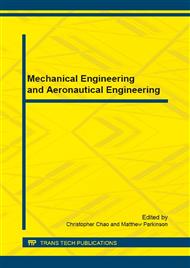p.73
p.78
p.83
p.90
p.95
p.103
p.110
p.118
p.123
Variable Cross-Section Thin-Walled Composite Structure Modeling Based on the Super-Element Method
Abstract:
For slender structures (for example larger aspect ratio wing or fuselage), when they are under loads, the in-plane cross-section shape of these structures remains unchanged. Using this feature, in this paper, a new method called super-element method (SEM) is proposed with the hypothesis of in-plane rigidity. The stiffness matrix of one super-element which has reduced degrees of freedom compared with FEM is derived and they are assembled together to get the stiffness matrix of whole structure. Then through the boundary conditions, the stress and displacement distribution can be calculated out. Calculation analysis of three examples reveals the validity and feasibility of super-element method.
Info:
Periodical:
Pages:
95-99
Citation:
Online since:
March 2016
Authors:
Price:
Сopyright:
© 2016 Trans Tech Publications Ltd. All Rights Reserved
Share:
Citation:


